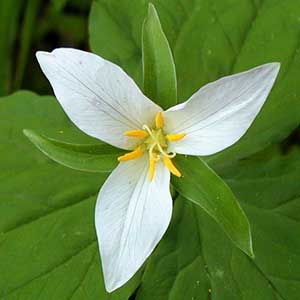Trillium ovatum
Trillium sulcatum
Pacific trillium, trillium, western trillium, western wake-robin, western white trillium, white or western trillium, white trillium
Barksdale trillium, furrowed wakerobin, southern red trillium
semierect to horizontal, short, stout, praemorse.
horizontal–slightly erect, thick, praemorse.
1–2, round, 2–5 dm, ± slender, glabrous.
1–4+, round in cross section, 3–7 dm, 2–2.5 times as long as bract, stout, glabrous.
sessile, subsessile, or short-petiolate;
blade medium green, sometimes blotched and mottled, main veins prominent, ovate-rhombic, 7–12 × 5–20 cm, continuing to expand during anthesis, base rounded, apex acuminate.
subsessile;
blade obovate to broadly elliptic, 13–20 × 8–22 cm, not glossy, base attenuate, apex acuminate.
erect or nodding, odorless;
sepals spreading to horizontal, green, lanceolate to oblong-lanceolate, 15–50 × 6–20 mm, margins entire, apex acute;
petals erect-ascending, usually wide-spreading from base, exposing entire pistil, white or with pink or blush markings, lacking V-shaped markings, fading to rosy pink, purple, or dark red, veins not deeply engraved, ± linear to widely obovate, 1.5–7 ×1–4 cm, widest at or above middle, thin-textured, margins flat to undulate, apex acuminate;
stamens prominent, slightly recurved-spreading to straight, 10–18 mm;
filaments white, shorter than anthers, slender;
anthers yellow, 4–16 mm, slender, dehiscence latrorse-introrse;
ovary green or white, ovoid, 6-angled, 5–12 mm, attachment ± 3/4 ovary width;
stigmas recurved, barely connate basally, greenish white or white, linear, not lobed adaxially, 6–10 mm, uniformly thin;
pedicel erect to leaning, 2–6 cm.
facing outward at right angle to pedicel, above bracts, odor faintly musty, like fresh fungus;
perianth gaping, strongly 3-dimensional;
sepals spreading, usually streaked or entirely purplish maroon, occasionally entirely green except on margins, elliptic, 15–38 × 9–15 mm, margins entire, apex strongly sulcate-acuminate;
petals carried somewhat forward to recurved-spreading in distal 1/2, usually dark reddish maroon to purplish, rarely cream to soft yellow, pink, white, or 2-colored, heavy-veined, ovate to broadly ovate-overlapping, 1.8–5 × 1–3 cm, heavy-textured, apex acuminate, rarely somewhat sulcate;
stamens erect, ± equaling or slightly longer than ovary, 15–18 mm;
filaments purple to white, 3–5 mm, slender;
anthers straight, purplish to yellow, 5–12 mm, thick, dehiscence introrse;
connectives equaling or ± shorter than anther sacs;
ovary usually dark purple, globose to flask-shaped, 6-angled, 14–18 mm, broadly attached basally;
stigmas prominent, recurved, distinct, purple, not lobed adaxially, basally thickened, gradually tapered, 2–5 mm, fleshy;
pedicel usually stiffly erect (rarely almost horizontal above bracts), straight, reflexed ± 90° at tip, 6–11 cm.
baccate, green or white, ± odorless, broadly ovoid, obscurely winged, 1.2–2.8 × 0.7–1.9 cm, pulpy-moist.
red, fragrance of fresh mushrooms, ± globose to pyramidal, 1.5–3 × 1.2–2.8 cm, juicy to pulpy.
= 10.
= 10.
Trillium ovatum
Trillium sulcatum
Varieties 2 (2 in the flora).
(Discussion copyrighted by Flora of North America; reprinted with permission.)
Trillium sulcatum is present mainly on the Cumberland Plateau and is absent from the Great Smoky Mountains and the southern Blue Ridge Mountains.
T. S. Patrick (1984) described Trillium sulcatum flowers as “relatively small and turned downward.” This is true of plants from the type locality; however, in most plants of the Cumberland Plateau, the flowers are quite large and flattened, and the petals are recurved distally and face outward.
(Discussion copyrighted by Flora of North America; reprinted with permission.)
1. Bracts sessile; petals lanceolate to obovate, 1.5–7 × 1–4 cm | var. ovatum |
1. Bracts distinctly short-petiolate; petals linear to linear-lanceolate, 0.5–2.4 × 0.2–0.6 cm | var. oettingeri |
- Local floras:
BC,
CA,
OR,
WA
- Local Web sites:
CalFlora,
CalPhotos,
Flora NW,
PNW Herbaria,
Turner Photog.
WildflowerSearch
iNaturalist (observations)
USDA Plants Database
- LBJ Wildflower Center
- SEINet
- Plants of the World Online
- Encyclopedia of Life
- Wikipedia
- Google Image Search


